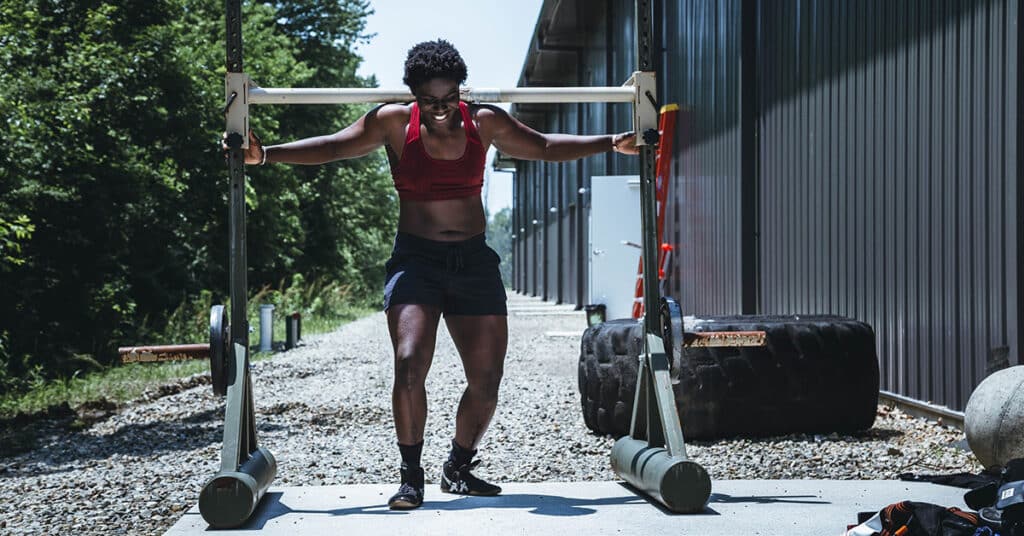
Yoke Carry Workouts and Technique Tips for an Iron Mind and Strong Body
Yoke Carry Workouts are a superb way to test and build mental and physical strength.
They are one of the movements where you will be able to lift the most weight, and give tremendous feelings of satisfaction after each workout is completed.
What is a Yoke?
A yoke is a bulky piece of fitness equipment often seen in Strongman training and events that is made up of a large metal frame with a crossbar. Each of the four corners of the frame can be stacked with weight, allowing you to carry very heavy loads.
What is a Yoke Carry?
Popular in strongman circles, the yoke carry involves picking up and carrying a weighted metal frame on your back over a set distance.
How Heavy is a Yoke?
The Rogue Fitness Y1 Yoke weights 83.9kg/185lb (and doubles as a squat rack)
The Mirafit M3 Strongman Yoke has the following measurements and weights.
- 183cm (72″) – net weight approx 70kg/154lb
- 233cm (92″) – net weight approx 75kg/165lb
What Muscles does the Yoke Carry Work?
Using a yoke in your training will significantly strengthen your upper back, posterior chain, legs, hips, and core while making ordinary activities—like moving furniture or carrying heavy suitcases feel like an easy day at the gym.
Can you use a Yoke as a Squat Rack?
Yokes will vary based on the manufacturer, but they will always have (a) an adjustable crossbar (to allow for athlete’s varying heights) and (b) four plate storage posts to stack plates. Some yokes also double as a squat rack.
Benefits of the Yoke Carry
Most people have a dominant arm, but did you know most people also have a dominant leg?
If you don’t know which leg is your dominant, have someone push you from behind which will cause you to step forward. The leg you instinctively step forward with is your dominant leg.
You can also jump from one leg and the jumping leg would be the dominant one.
This might not seem like a big deal, but it could be causing some serious strength imbalances. Yoke Carry Workouts are an excellent way to identify and destroy muscular imbalances.
Yoke Carry Technique Tips
Set Up
Set up the yoke so that there are 4 to 6 inches of clearance when you stand with the implement. Any less and slight deviations in balance during the carry can make the implement touch the ground, and any more clearance may eventually impede the loads that you can stand up to carry.
Narrow Stance
It is my experience and observation that most people do too wide of a pick up on the yoke. A wider stance will make the actual pick up a little easier but you will then have to shift your feet closer in to get back into walking position.
Doing this will cause you to lean over to one side forcing a slow and unsteady start. You would be better off with a medium to narrow stance that transitions you into your stride easier. The only time you want a wider pick up is when you are going for a near maximum or maximum weight pick up.
Hand Placement
There are two common hand placements when carrying the yoke. The most common in the strongman community is to have your hand pressing out into the uprights below shoulder level. This method makes for the fastest transitions and allows for the greatest limitations in flexibility.
Many CrossFit athletes place their hands on the crossbar outside shoulder width, not too dissimilar to a back squat. Use whichever is most effective to bear the load.
Breathing
Other than strength, the number one reason people drop the yoke is because of their breathing. Most of the time people will hold their breath from the start which is okay if you finish the yoke incredibly fast.
Although if you can’t hold it the whole way, you are going to eventually let that air out which will fold you over and the yoke will go with you. A better approach is to keep a big chest with a certain amount of air and take quick breaths.
Abs and Core
If you have weak abs, your yoke will be nowhere near what it could be. Weak abs will cause you to fold over and put a lot of strain on your back. If your abs are strong, you will be able to support the weight and stay more upright. Do some specific ab work in training and you will see the difference on yoke.
The pick-up and carry will feel stronger and more powerful.
This doesn’t have to be anything crazy just make sure to hit some abs once or twice a week and that should be sufficient. Of course, everything will benefit from stronger abs, but yoke in particular will see improvement.
Learn how to build stronger abs and core
Yoke Carry Workouts
WORKOUT 1
5 rounds:
- 5 x Atlas Ball over Yoke
- 5 x Burpee over Yoke
- 20m Overhead Yoke carry
- 20m Zercher Yoke carry
WORKOUT 2
6 Rounds for time:
- 7 Burpees Over Bar
- 7 Reverse Lunges (60/40 kg)
- 17 calorie Assault Bike
- 7 Dumbbell Snatches (22.5/15 kg)
- 7 Forward Lunges (60/40 kg)
- 17 Back Extensions
- 7 x 20 metre Yoke Walks (60/40 kg)
YOKE CARRY WORKOUT 3 – PARTNER
Share between the two athletes.
2 Rounds for time:
- 50 feet Yoke Carry (500/350 lb)
- 15 Dumbbell Snatches
- 50 feet Yoke Carry (500/350 lb)
- 15 Clean-and-Jerks (135/95 lb)
WORKOUT 4
This yoke carry workout is great if you want the stimulus but don’t have all the right equipment.
AMRAP in 20 minutes
- 10 Ground-to-Overheads (95/65 lb)
- 100 foot Overhead Barbell Carry (95/65 lb)
- 20 Reverse Front Rack Lunges (95/65 lb)
- 10 Unbroken Deadlifts (95/65 lb)
Every 3 minutes, perform:
1 Burpee
After the 20-minute clock, complete:
1 Burpee
On a 20-minute clock, perform as many repetitions as possible (AMRAP) of 10 Ground-to-Overheads, 100 foot Overhead Barbell Carry, 20 Reverse Front Rack Lunges, and 10 Unbroken Deadlifts. Every 3 minutes starting at 3:00, complete 1 Burpee before continuing the workout. At the end of the 20-minute clock, perform 1 Burpee.
Score is the total number of repetitions completed before the 20-minute clock stops.
Movement Standards
Ground-to-Overhead: May be any technique that moves the Bar from the ground to over the athlete’s head (Snatch, Clean and Press, etc).
Overhead Barbell Carry: The Overhead Carry begins with both feet behind the start line and finishes the same way. If doing the carry in sections, such as 4X 25’, the feet must both pass over the distance mark before turning around. It may also be scaled to a front rack or bear hug if the athlete cannot go overhead.
Front Rack Reverse Lunge: May also be positioned in back rack or bear hug (plate) if the front rack is unattainable. Knee makes light contact with the deck and the athlete must stand fully with both feet together to count the rep.
Deadlift: Deadlift may be any style as long as the Bar begins on the ground and athlete fully extends into lockout.
Burpee: Burpee may be scaled to meet the athlete’s skill level but are expected to be full contact with the ground with a jump brining hands overhead with hips extended.
Tips and Strategy
The Burpee will break your sets on a known interval, so challenge yourself to flow from Ground-to-Overhead right into the Overhead Carry. From the Carry into the Lunge.
Catch your breath after the Lunge and before starting the Deadlift.
Intended Stimulus
High heart rate. The Burpee will become “rest” as athletes will be forced to stop to do the single rep.
Scaling Option (Beginner)
Perform with unloaded Bar, or Plate 35/25 or 25/15
Burpee changes to an Up/Down, aka, Squat Thrust
YOKE CARRY WORKOUTS – PARTNER 5
Partner 1-
- 100 foot Yoke Carry (245/185)
- 6 Pull Ups
- 100 foot Suitcase Carry (75/50)
- 15 Toes to Bar
Partner 2-
Max Calorie Row
Workout concludes when 400/300 calories are reached on the rower. Athletes change when Partner 1 is one with the 4 movements.
This is a fun partner workout that challenges the athlete’s gymnastics ability but also grip strength. Both athletes should try to work quickly through the first 4 movements so the other athlete isn’t stuck rowing the whole time. Jumping onto the rower after the toes to bar challenges the abs on the recover portion of the rowing.
Beginner athletes could reduce the weight and scale down the gymnastics movements from pull ups to ring rows or supine rows and from toes to bar down to hanging knee raises or abmat situps.
WORKOUT 6
For time do each of 4 rounds:
- 20m Heavy Yoke Carry
- 5 Back squats
- 20m Heavy Carry
*rest 2:00 between
*go HEAVY
Yoke can be replaced by anything. Carry sandbag, kettlebells, dumbbells.
Make it very challenging for 20 metres.
Back squats should he done with weight that will leave you with buffer of 2-3 reps. Somewhere around 75% of 1RM.
If you enjoy trying new exercises, add these Dumbbell Swing Workouts into your training.



